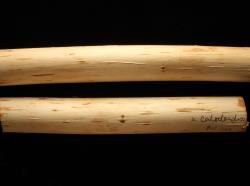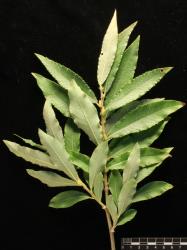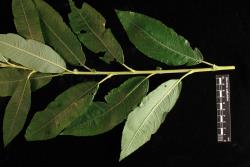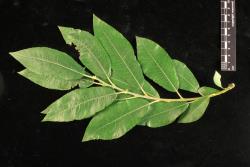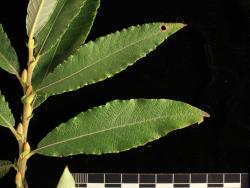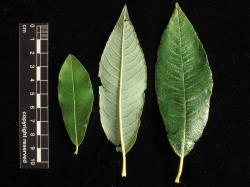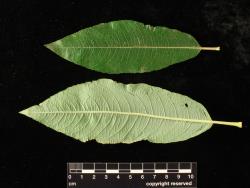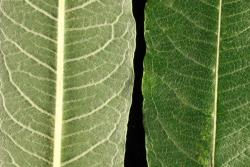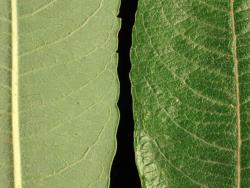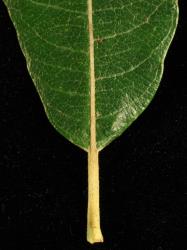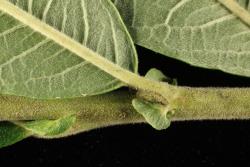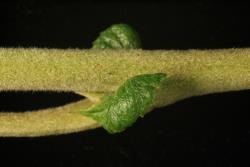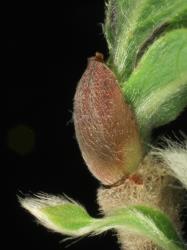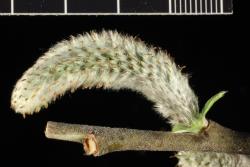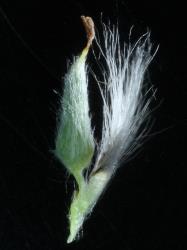Erect multi-stemmed shrub or small tree to 12 m. Branchlet wood ridges dense, 3–21 mm long. Current year's branchlets densely velvety, hairs persistent or not. Year-old branchlets densely tomentose, 4.1–4.6 mm diameter. Two-year-old branchlets red-brown (UCL43), glabrous or nearly so. Bud scales 7.5–9.0 mm long, 4–5.5 mm wide, 2.5 mm deep, strongly 2-angled, beaked at the apex, red-brown, densely tomentose. Leaves alternate. Stipule usually persistent, usually 7–18 mm long, narrowly ovate. Petiole 7–24 mm long, densely tomentose, glands absent, base of petiole enlarged. Emerging leaves green, with moderately dense tomentum. Proximal leaves entire. Leaf lamina 100–173 mm long, 28–57 mm wide, length to width ratio 3.0–3.7:1, narrowly elliptical or narrowly obovate, not falcate; base narrowly truncate; apex acute; leaf galls absent; margins crenate and serrate, finely revolute; upper lamina surface slightly bullate due to impressed veins, slightly to moderately glossy, glabrous to sparsely tomentose but more densely tomentose on the midvein, stomata absent; lower lamina surface midvein and side-veins raised, netted veins raised, distinctly glaucous, sparsely to moderately densely tomentose. Hairs silver, brown hairs occasionally present on upper leaf surface. Catkins female, emergence before leaves. Flowering branch 18–25 mm long with 4 reduced leaves below catkin. Female catkin 17–25 mm long, 9–10 mm diameter; catkin rachis not visible between flowers. Catkins extending to 85 mm long as capsules mature. Flower bract 1.5–2.0 mm long, 0.4–1.0 mm wide, dark brown to black distally, green proximally, flat; apex acute to rounded; long-silky on all surfaces; female bracts persistent. Female nectary 1, 0.54 mm long, 0.26 mm wide, yellow; ovary 2.0–3.0 mm long, densely long-silky hairy, exceeding flower bract; stipe 0.7–1.6 mm long, densely hairy; style base 0.3–0.7 mm long, style arms 0.7–0.85 mm long, unlobed, yellow-green.
An erect-branched shrub or tree to 12 m with densely velvety tomentum on 1-year-old branchlets, and long ridges (up to 21 mm long) on the branch wood, which can be as dense as those seen on the branch wood of S. cinerea. Leaves are large (lamina up to 173 mm long and 57 mm wide) with a long, narrow petiole 7–24 mm long, and persistent stipules that are up to 18 mm long. Leaves are distinctly glaucous on the lower surface. Emerging leaves have a dense tomentum, which becomes sparse on the upper surface of mature leaves but persists as moderately dense crinkled hairs on the lower leaf surface, but not so dense as to obscure the glaucous leaf surface. The clone is female, catkins are sessile and lengthen greatly after flowering to become long-cylindrical to 85 mm long, with dense, long-silky hairs obscuring the bracts and ovaries. Flower bracts are initially crimson, then bicoloured: black distally, green proximally. Ovaries are hairy and have a short stipe that elongates during flowering. The style base and style arms are long (ca. 0.7 mm each), and the style arms are unlobed.
There are very similar male and female clones that are probably of similar parentage, but independent origin, that have been referred to as Salix 'Aquatica Gigantea'. Salix 'Aquatica Gigantea Germany' is represented in New Zealand by PN604, a hexaploid female clone. Salix 'Aquatica Gigantea Korso' is a male tetraploid clone represented in New Zealand by PN669. These clones were sent to New Zealand by Ken Stott, Long Ashton Research Station, UK (Stott 1991), who obtained them elsewhere in Europe (from Finland in the case of S. 'Aquatica Gigantea Korso'), where they were valued as basket willows for their fast growth and are currently being trialled for biomass production. Kuzovkina (2015) suggested that S. 'Aquatica Gigantea' may be either particularly vigorous selections of S. gmelinii Pall. (a species related to S. viminalis from central Russia), or a hybrid distributed by Carl Jensen from Denmark during the early 1950s. Differences between S. ×calodendron and S. 'Aquatica Gigantea' (PN604) are: leaf length (105–173 mm versus 143–163 mm long, respectively), width (30–57 mm versus 22–31 mm wide), leaf lamina length to width ratio (3.0–3.7:1 versus 2.9–5.5:1), and flower bract length (1.5–2.0 mm versus 3.9 mm). The lower leaf surface of S. 'Aquatica Gigantea' is not glaucous. PN604 has a very long style base, 1.2 mm long, and very long style arms, 1.2–1.4 mm long, which often become deeply bilobed (style arms are never bilobed in S. ×calodendron). These clones do not appear to have been distributed beyond Palmerston North, and there are no wild collections, whereas S. ×calodendron has frequently been found in the wild, mainly in Canterbury.
Similar to Salix ×smithiana, and in spring, when leaves are immature, they may be very difficult to distinguish. Both are female only in New Zealand, and both have long style bases and long but unlobed style arms. Both have catkins that elongate greatly after flowering. Salix ×smithiana has narrower leaves (21–23 mm versus 28–57 mm in S. ×calodendron) that are wider below the middle when not elliptical, whereas S. ×calodendron is widest above the middle (narrowly obovate). Salix ×smithiana has a shorter petiole (9–12 mm versus 13–24 mm in S. ×calodendron). Salix ×smithiana is indistinctly glaucous on the lower leaf surface, the surface obscured by dense, persistent hairs. Wood ridges are sparse and short in S. ×smithiana (dense and long in S. ×calodendron).
Similar to Salix cinerea, one of its parents. Both have dense wood ridges, but the ridges are longer in S. cinerea, averaging about 13–22 mm while in S. ×calodendron they range from 3–21 mm long. The mature leaves of S. ×calodendron are larger than those of S. cinerea (100–173 mm long versus 65–103 mm in S. cinerea), and the petiole longer (7–23 mm long versus 4–12 mm long in S. cinerea). Hairs on the underside of the mature leaves of S. ×calodendron are sparser than in S. cinerea.
Similar to Salix viminalis, its other parent, but leaves are wider (22–41 mm wide versus 5–33 mm in S. viminalis).
Southern North Island (Waiohine River 1953, Akatarawa, Hutt River 1950, probably planted), Canterbury (Hororata 1964, Christchurch 1964, Rakaia Huts 1964, Lake Pukaki 1970, Washdyke 1963, St Andrews 1981, Fairview 1964, Taiko Flat Road 1964, Otaio River 1981, Rangitata River 1964, Waimate 1966).
First collection: CHR 88524, A. J. Healy 53/552, 17 March 1953, Waiohine River, "along edge of swampy river".
First publication: Sykes (1982).
Flowering: Late August–mid-October.
Unknown.



